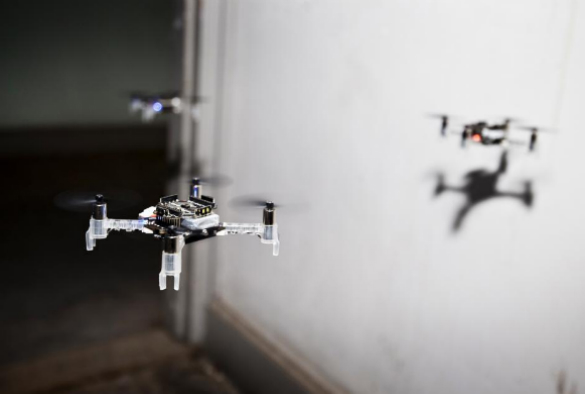Swarm of tiny ‘insect-inspired’ drones explores unknown environments
Published on

Researchers have taken inspiration from the insect world to create a swarm of tiny drones that can explore unknown environments completely by themselves.
University of Liverpool Professor Karl Tuyls is part a team whose new work, published today in Science Robotics, represents a significant step forward in the field of swarm robotics.
Swarms of tiny flying robots hold great potential for exploring unknown, indoor environments and could transform disaster search and rescue missions. Their small size allows them to move in narrow spaces, and their light weight makes them safe for operating around humans. Until now, this task has been out of reach due to the lack of adequate navigation strategies.
Now, following four years of work, researchers from TU Delft and Radboud University in the Netherlands and the University of Liverpool present a solution called the ‘swarm bug algorithm’ that allows a swarm of tiny flying robots to autonomously explore an unknown environment and subsequently come back to the departure point.
Swarm benefits
As part of the project, researchers equipped tiny 30g commercial ‘off-the-shelf’ drones with cameras and sent them out in an indoor office environment to find two dummies representing victims in a disaster scenario. This proof-of-concept search-and-rescue task clearly showed the advantage of having a swarm. Within 6 minutes, a swarm of 6 drones was able to explore about 80% of the open rooms – which would be impossible for one of the drones alone. Furthermore, swarming also turned out be useful for redundancy. One drone found a victim, but due to a hardware failure of the camera, it could not bring back any images. Luckily, another drone captured the victim on camera as well.
Swarm challenges
One of the key challenges in achieving swarm exploration lies at the level of the individual intelligence of the drones. The team designed a method for the small drones to detect and avoid each other by having each drone carry a wireless communication chip and then making use of the signal strength between these chips.
However, the most daunting challenge was in making the small robots navigate an unknown environment by themselves. The reason for this is that tiny robots are very limited in terms of sensing and computation. The team tackled this by drawing inspiration from the relative simplicity of insect navigation when developing their new ‘bug algorithm’.
Bug algorithms
Insects do not make highly detailed maps. Instead, they retain landmarks and behaviorally relevant places like food sources and their nest. “The main idea underlying the new navigation method is to reduce our navigation expectations to the extreme: we only require the robots to be able to navigate back to the base station”, says Guido de Croon, principal investigator of the project. “The swarm of robots first spreads out into the environment by having each robot follow a different preferred direction. After exploring, the robots return to a wireless beacon located at the base station.”
“The proposed navigation method is a novel type of bug algorithm”, adds PhD student Kimberly McGuire, who carried out the project work. “Bug algorithms do not make maps of the environment but deal with obstacles on the fly. In principle, detailed maps are very convenient, because they allow a robot to navigate from any point in the map to any other point, along an optimal path. However, the costs of making such a map on tiny robots is prohibitive. The proposed bug algorithm leads to less efficient paths but has the merit that it can even be implemented on tiny robots.”
Professor Tuyls, from the University’s Department of Computer Science, says: "The insect-inspired navigation method is not only an important innovative step forward in the research to deploy swarms of pocket drones in search-and-rescue missions, but it also holds great promise for tackling other similarly complex tasks with robot swarms in the future, e.g. assisting with robotic warehouse commissioning or monitoring tasks in agriculture."
The project was financed by the Dutch national science foundation NWO Natural Artificial Intelligence programme.
Research reference:
McGuire et al., Minimal navigation solution for a swarm of tiny flying robots to explore an unknown environment, Science Robotics, 4, eaaw9710 (2019) DOI: 10.1126/scirobotics.aaw9710